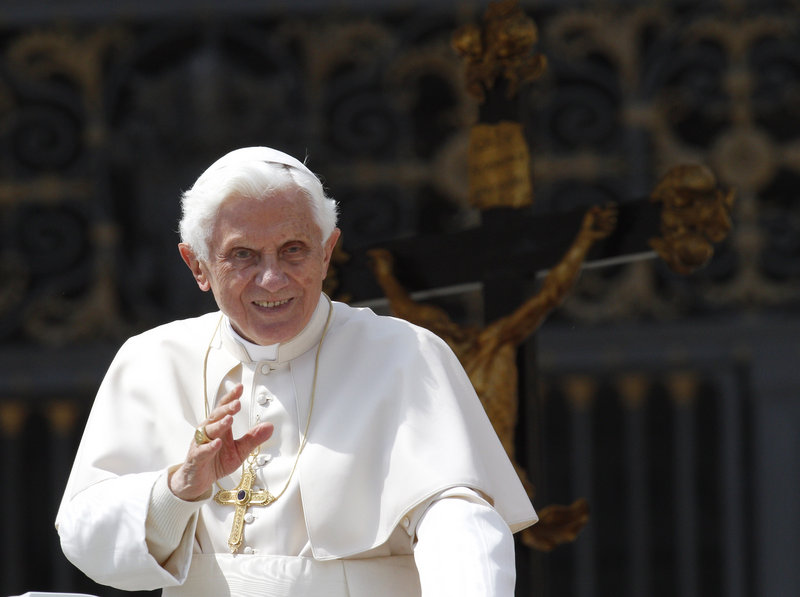VATICAN CITY — Pope Benedict XVI began his eighth year as pope on Tuesday after spending the waning days of his seventh year driving home his view of the Catholic Church by launching a divisive crackdown on dissenters and providing an equally divisive opening to a fringe group of traditionalists.
The coming year may see more of the same as the Vatican gears up to celebrate the 50th anniversary of the Second Vatican Council, the 1962-65 church meetings that reshaped the Catholic Church and are key to understanding this papacy and Benedict’s recent moves to quell liberal dissent and promote a more conservative brand of Catholicism.
Tuesday marked the anniversary of the start of Benedict’s pontificate, which officially began April 24, 2005, with an inaugural Mass in St. Peter’s Square. The pope promised then not to impose his own will on the church, but to listen “to the word and the will of the Lord, to be guided by him, so that he himself will lead the church at this hour of our history.”
Seven years later, Benedict has certainly left a mark on the church, pressing a conservative interpretation of Vatican II’s key teachings, appointing like-minded bishops and making his priority the revitalization of traditional Catholicism in a world, which he often laments, seems to think that it can do without God.
He set out many of those priorities in a December 2005 speech to his closest collaborators running the Vatican, insisting that Vatican II didn’t represent a break from the past as many liberal-minded Catholics would like to think, but rather a renewal of the church’s core teachings and traditions.
Last week, the Vatican put those words into action, cracking down on the largest umbrella group of nuns in the United States, the Leadership Conference of Women Religious.
The pope’s old office, the Congregation for the Doctrine of the Faith, appointed a bishop to revise the conference’s statutes and review its programs and publications. The Vatican accused the group of taking positions that undermine church teaching on the priesthood and homosexuality while promoting “certain radical feminist themes incompatible with the Catholic faith.”
Two weeks earlier, the pope himself took to task a dissident group of priests in heavily Catholic Austria who have openly called for ordaining women and relaxing the celibacy requirement for priests. The pope questioned whether their call for disobedience was more about imposing their own ideas on the church than renewing it.
At the same time, on the very day it announced the crackdown on the U.S. nuns, the Holy See said it was nearing agreement to bring an ultra-traditionalist conservative group of Catholics back into communion with Rome after two decades of schism.
The group, the Society of St. Pius X, broke from Rome after rejecting many of the teachings of Vatican II, particularly its outreach to Jews and people of other faiths, and the sanctioning of the New Mass in the vernacular that essentially replaced the old Latin Mass.
Benedict has gone to tremendous lengths to reconcile with the group, fearing the expansion of a parallel, pre-conciliar church that already boasts more than 550 priests and 200 seminarians.
To critics, the coincidence was remarkable: the Vatican was in a way rejecting the U.S. nuns who had embraced Vatican II and its call to go out into the world to serve the poor, while embracing the Society of St. Pius X that had rejected Vatican II.
Top officials at the Leadership Conference of Women Religious have said they were “stunned” by the Vatican decision and taken by surprise by its gravity. Online petitions supporting them have been launched, and one Jesuit author, the Rev. James Martin, has started a Twitter campaign, WhatSistersMeanToMe, highlighting individual nuns who had an impact on him and others.
Conservative Catholics have long complained that the majority of sisters in the U.S. have grown too liberal and flout church teaching on issues such as homosexuality and a male-only clergy. The Vatican, in its admonition of the women’s conference, complained that speakers at its assemblies often contradict or ignore core church teaching and that Catholic doctrine as a whole isn’t stressed enough in the conference’s member communities.
Conservatives have championed Benedict’s move to bring about a more orthodox faith to the church, even at the expense of popularity among liberals.
“Benedict understands his mission as custodian of the faith,” said the Rev. Robert Gahl Jr., an Opus Dei priest and professor of moral philosophy at Rome’s Pontifical Holy Cross University. “The pope has little interest in opinion polling and focus groups. He is not going to adjust the doctrine according to popular opinion or majority belief. Benedict’s aim is to unite the church around the faith handed down by Jesus, the church’s founder.”
Send questions/comments to the editors.



Success. Please wait for the page to reload. If the page does not reload within 5 seconds, please refresh the page.
Enter your email and password to access comments.
Hi, to comment on stories you must . This profile is in addition to your subscription and website login.
Already have a commenting profile? .
Invalid username/password.
Please check your email to confirm and complete your registration.
Only subscribers are eligible to post comments. Please subscribe or login first for digital access. Here’s why.
Use the form below to reset your password. When you've submitted your account email, we will send an email with a reset code.